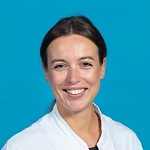Course Report
Multidisciplinary Management of Head and Neck Oncology - PDF Version
9-12 October 2022, Lyon, France
Course director:
- Vincent Grégoire, radiation oncologist, Centre Léon Bérard Lyon, France
Could you please briefly introduce yourself?
My name is Marta Capala, and I am a radiation oncologist at Erasmus Medical Center (EMC) in Rotterdam, The Netherlands. In 2020 I completed my residency at the Department of Radiotherapy, EMC, and then remained there on the staff.
Why did you choose to attend this course?
Both my clinical and research interests concern patients with tumours of the head and neck (H&N). EMC is the largest radiotherapy department that treats patients with H&N tumours in The Netherlands. However, as this group of tumours is heterogeneous, and some histologies and presentations are rare, it takes several years of exposure to them for clinicians to gain sufficient experience in treating them. As a young member of staff, I wanted to benchmark my knowledge against the standard of care that was discussed within the course.
What aspects of the course were most interesting to you and why?
As a radiation oncologist, I have limited experience with the technical side of surgical treatment. Hearing experienced surgeons talk about the treatment planning, limitations and consequences of the use of various surgical techniques helped me to understand their considerations when they chose one surgical technique over another, or opted for a non-surgical method of treatment.
Did the course activities improve your knowledge and skills in the relevant subject?
The course enabled me, first, to consolidate the knowledge that I had already, and second, to build on it, because the programme allowed ample discussion time in which I could ask many questions that arose from everyday clinical practice and hear the opinions of the course faculty and fellow participants.
Did the course meet your expectations? If so, how?
Partly. As mentioned above, the discussions that were held during various sessions were very informative and valuable. However, I felt that very little space was made for discussion of novel and emerging concepts within radiotherapy of H&N tumours, such as proton therapy, hypofractionation or workflows that involved the use of magnetic resonance alone. I believe that the addition of a block in which these novel concepts would be addressed would make the course more attractive for those participants who already have a background in treating H&N cancer patients.
List three important takeaways following the course.
- Treatment of H&N tumours can only be successful as a multidisciplinary team effort.
- Shared decision-making with the patient must involve discussion of the profiles of the side effects as well as the oncological outcomes of the treatment.
- Well-defined contouring guidelines must be followed to improve uniformity in treatment. This procedure then enables the comparison of results from various treatment centres.
How will what you have learned be implemented in your daily clinical practice?
A lot of the questions I brought up had originated from my daily clinical practice, and many concerned cases that had been discussed in the multidisciplinary tumour board (MDT). I feel better equipped to participate in our MDT now that I have knowledge of various treatment options and considerations regarding them.
How would you encourage someone who has never been to a European SocieTy for Radiotherapy and Oncology (ESTRO) course to join this course?
I would highlight that participation in an ESTRO course not only gives you a comprehensive overview of the standard of care, but also offers a lot of space for discussion on the topics particularly relevant to you. The return to in

Marta Capala
Radiation Oncologist
Erasmus Medical Center
The Netherlands